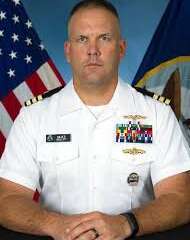Speakers
6 speakers
Date & Time
On Demand
Webinar
Technology
Almost three years ago, Adm. Michael Gilday, the Navy’s then-top officer, gave each of the organizations’ leaders a challenge: a mantra now familiar across the service as “get real, get better.” In short, it was a service-wide call to stop hiding problems for fear of negative career consequences. Instead, the idea goes, leaders should actively hunt problems down and then figure out how to fix them.
The Navy’s logistics and supply community has taken that message to heart in ways that go far above the individual unit level. Dogged by years of well-publicized aircraft downtime and shipyard maintenance delays, several of the service’s large systems commands (SYSCOMs) are working both at their own levels and with one another to figure out the root causes and systematically address them, via a sweeping effort called the Naval Sustainment System.
NSS’s origin story goes back to 2018 — before the “get real, get better” slogan became common parlance in the Navy. James Mattis, then the Defense secretary, laid down a hard marker for military aviation, saying 80% of each service’s planes needed to be in a mission-capable status.
Naval Air Systems Command (NAVAIR), the SYSCOM in charge of buying and maintaining the aviation fleet, managed to do that within a year.
“The Super Hornet was, at best, 50% mission capable for the previous decade. And so everyone throughout the enterprise thought that it was an impossible task,” said Dave Heinauer, the current NSS-Aviation team lead for NAVAIR’s fleet readiness centers.
He said the command only pulled it off by first understanding how many aircraft were truly grounded, and what the root causes were. At first, no one was even sure what the denominator was: 80% of what? The answer turned out to be that the Navy owned 341 airframes that needed to be ready.
“Before that, we had all developed our own metrics internally, and our metrics were all green. But when we developed that 341, our metrics instantly became all red. And we all had to do our homework to figure out what our contribution was, and how we partner to get to 341,” he said. “We found out, for example, that one of our fleet readiness centers had 280 line items that were contributing to aircraft downtime. So we went in and figured out, ‘Ok, what do we need? How do we partner with the Defense Logistics Agency and Naval Supply Systems Command to get the piece parts that we need, and how do we improve our own internal processes to meet the required demand and turnaround time to get those parts back on the shelf so that the warfighter can put these planes back together?’”
Applying the same concepts to ships
Naval Supply Systems Command (NAVSUP) and Naval Sea Systems Command (NAVSEA) took some of those early lessons to develop their own spins on NSS, which worked in concert as the Navy started to tackle long-delayed maintenance periods for ships. For the last several years, NSS-Supply and NSS-Shipyards have been working to understand, and more importantly, resolve, individual problems that are hampering readiness for the Navy’s surface fleet.
“As we started to dig into what aviation was seeing — pulling a lot of metrics and using data-driven decisions on where to focus their efforts — there was a quick realization that we needed more of an enterprise approach on this,” said Capt. Bruce Reilly, the director for industrial supply chain operations at NAVSEA. “The maintenance of an aircraft carrier is an incredibly complex business, and when they really peeled it back, they came up with nine key areas that would eventually become the pillars for what became the NAVSEA Transformation Office. Cross system collaboration was kind of built into the system as we established it here at NAVSEA.”
One early example that emerged as the two commands started to work on ship readiness: data analytics showed that, on average, only about 30% of the parts needed to complete a submarine or surface ship’s planned maintenance were available when the vessel entered the yard. And those late-arriving supplies, in turn, are responsible for about 30% of the total delays in ships’ scheduled maintenance periods.
Cmdr. Kirk Engler, the director of NSS-Supply at Naval Supply Systems Command, said the two commands were then able to restructure their planning processes for each type of ship maintenance availability as they worked toward the goal of 75 mission-capable surface ships. That smarter planning process also helped NAVSUP manage its supply chain in ways that cut costs in the Navy’s working capital fund by more than $1 billion.
“We found out what the similarities and the standards were, and we were able to plan toward the standard with the goal of having material available at the start of the maintenance availability. Not being ordered after the start, but already on the pier at the start of the availability,” Engler said. “The challenges that we have in the maritime ship domain is that we have a lot of private shipyards, and we’re going to have to work through that challenge with the contracted shipyards in order to have the same results.”
Meanwhile, Naval Information Warfare Systems Command (NAVWAR) and its program executive offices are working on ways to extend the data analytics that have made up previous NSS initiatives, said Capt. Vince Erno, NAVWAR’s director for logistics programs.
“We’re taking a look at where the largest opportunity to improve operational availability exists and then working to improve that fleet readiness by increasing the visibility of the parts that are resident within NAVWAR, NAVSUP and the retail system on board the ships,” he said. “Making sure that end-to-end visibility is captured will pay big dividends, reduce potential procurements and certainly lead to cost avoidance. The goal is being 100% ready, with material ready for issue when the warfighter needs it in a contested logistics type of environment.”
Governance, collaboration key to NSS
Navy officials say the way they’re implementing the wide-ranging logistics improvement effort has also eliminated a lot of finger-pointing. If the idea is to focus on how your own organization’s processes are degrading readiness, that, in and of itself, tends to reduce the natural tendency to blame other parts of the supply chain for the broader Navy’s problems.
But another key, they say, has been the governance structure the service has established to push NSS forward and decide which initiatives to pursue next.
“We have a drumbeat that starts with a monthly strategic sync, where we bring all the key players from the SYSCOMs, the warfare centers and the fleet customers all together,” Engler said. “And our GS-15 level leads for each of our initiatives give briefs on their status of their initiatives, the accomplishments they’ve made. That also gives them an opportunity to raise up barriers so that the leadership can take action to remove those barriers. Then, on a quarterly basis, that also gets briefed to the vice chief of naval operations … it really has opened the conversation of sustainment and readiness across SYSCOMs. It’s gotten everybody on the same sheet of music, and I find that the most encouraging thing, because these are really big problems that no one SYSCOM can tackle on its own.”
Raising issues to leadership early — before they become crises — has been key to the entire NSS effort since the beginning, NAVAIR’s Heinauer said.
“We’ve had decades of a culture that encourages people to handle problems at the lowest level, but that usually ended up in a situation where the problem became so dramatic that it now required flag intervention,” he said. “With the governance structure we have set up through NSS, we’re giving people the opportunity to elevate the problems at low levels, but we’re having frequent-enough governance meetings that those barriers are now elevating up higher and higher more quickly — so when they do get to the flag officer, the situation isn’t in dire straits. It’s, ‘Hey, we see this on the horizon, we need your help.’”
Learning Objectives:
- NSS overview
- Collaboration across the NSS
- Achievements in NSS
- Industry analysis
Speakers

Dave Heinauer
Transformation and Sustainment Team Lead for NSS-Aviation
Naval Air Systems Command

Capt. Vince Erno
Director for Logistics Programs
Naval Information Warfare Systems Command

Capt. Bruce Reilly
Director for Industrial Supply Chain Operations
Naval Sea Systems Command

Cmdr. Kirk Engler
Director, NSS-Supply
Naval Supply Systems Command

Percy Alexander
Director of Logistics and Enterprise Integration
RLO2

Jared Serbu
Deputy Editor
Federal News Network
Please register using the form on this page.
Have questions or need help? Visit our Q&A page for answers to common questions or to reach a member of our team.

